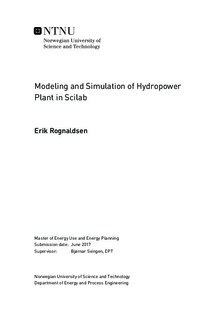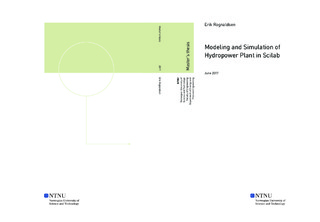| dc.description.abstract | A hydro power plant is modeled in a computer application called Scilab, an open source MATLAB clone with capabilities to create block diagrams and do system simulations. The system is designed to do both frequency regulation when running in island operation and power regulation in a stiff power network. The conduit system are set up with a dynamic penstock model, surge shaft and a rigid head-race tunnel. Draft tube and a lower surge shaft are also been implemented. It is used a linear turbine model which utilize linearized turbine characteristics of a designed turbine to get a detailed description of the turbine behavior. The linearization are performed with a computer program based on modified Euler s turbine equations deduced by Torbjørn Nielsen. The model is then evaluated up against a hydro power simulation tool called LVTrans, a program coded in LabVIEW based on the method of characteristics.
The scilab model shows good performance for simulations around its operating point. Simulation in island mode shows a frequency deviation between the models during a $10\%$ load drop of 0.25Hz, or 0.5%. Simulating in stiff grid both models responds similarly to a frequency change of +0.01Hz decreasing the turbine power output by 16.7% with a droop of 6%. The system simulation performance of mass oscillations and water hammer is also tested. The simulations was performed with a change in the friction factor to a more representative number for an turbulent and flow fluctuating situations. This gave good results compared to LVTrans simulations, but it gave too much friction at the end of the event as the mass flow fluctuations reaches zero.
The surge shaft model is evaluated up against a u-pipe test rig located at the water power laboratory. Comparing simulations to the rig tests gave indications that the model is suited for simulating transient pressure pulsations in form of mass oscillations. It also shows that the friction model brakes the pulsations too fast resulting in a decrease in amplitude and the time to reach steady state gets too short. | |

